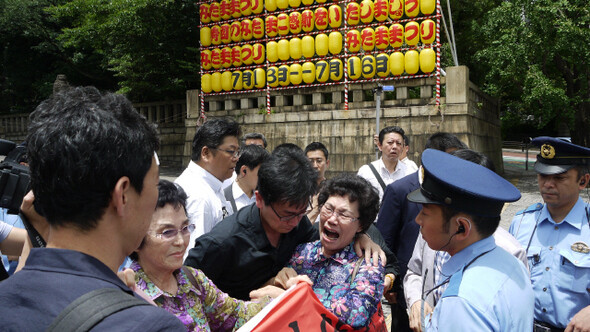hankyoreh
Links to other country sites 다른 나라 사이트 링크
Family of Koreans in Yasukuni Shrine stopped in their tracks

By Gil Yun-hyung, Tokyo correspondent
“This person has been waiting for seventy years. Why are you doing this?”
“Since we are the defendants and you are the plaintiff in an ongoing trial, we are unable to give an interview,” a representative for Yasukuni Shrine said.
It was 11 am on July 10, and a group of Koreans was standing in front of the gate to the Yasukuni Shrine in Tokyo. Facing firm resistance of the shrine’s employees, Park Nam-soon, 71, and those who were with her were unable to advance any further. Park had come to the shrine to find out how her father had been forcibly enshrined there.
Park and her family members desperately want to know why their father’s name had been listed at the shrine without permission from the family in advance or even notifying them after the fact, but these questions bounced off the wall of the shrine and lingered in the air. The shrine maintains that it cannot discuss matters that are currently under trial.
“The family members have come all the way from Korea. Why don’t you answer them with a little more respect?” said Akihiko Oguchi, venting his frustration, but in the end he could not change the shrine’s stubborn position. Oguchi is the attorney representing the plaintiffs suing to have their relatives’ names removed from Yasukuni Shrine.
The first hearing for the second round of a lawsuit demanding that the names of Koreans who were forcibly enshrined at Yasukuni be removed from the shrine’s list took place at the Tokyo Local Court on July 9.
After the first hearing, when the bereaved families said they wanted to learn how their father’s name had been listed at the shrine, the Japanese lawyers requested an interview with the shrine’s officials. The shrine turned down the request for an explanation on July 9. The following day, the family members visited the shrine themselves and repeated their request, but the shrine refused this as well.
Park’s father Park Man-soo was born in 1920 and joined the Japanese army in 1942, a month before his daughter was born. Assigned to Japanese forces in the South Pacific, the elder Park was killed in battle on Brown Island (now known as Enewetak Atoll, part of the Marshall Islands) in Feb. 1944, after less than two years in the army. This is the 70th year since the death of Park’s father. “I remember my grandmother never once shut the door to her house, waiting for my father to return,” Park said.
Finally forced to turn back in front of the shrine, Park stomped her feet in frustration. “I don’t get why the shrine would treat us like this,” she said.
“I’m here because my father was forcibly enshrined here. If they just erase my father‘s name, I won’t come to the shrine ever again, even if they asked me to,” Park yelled at the police officers who were blocking the way.
Unable to control her anger, Park started thrashing around, and a Japanese police officer warned her, “You just hit me two times.” At this, Japanese citizens who were there in support of the plaintiffs’ case got into a scuffle when they asked the police officers to treat the bereaved families with respect.
Yasukuni Shrine, which has been the crux of historical conflict in Asia since Japanese Prime Minister Shinzo Abe paid his respects there in Dec. 2013, is causing major emotional damage to the Koreans who are calling for their relatives names to be removed from the list at the shrine. The second hearing in the trial will take place at the Tokyo Local Court on Nov. 5.
Please direct questions or comments to [english@hani.co.kr]

Editorial・opinion
![[Column] Season 2 of special prosecutor probe may be coming to Korea soon [Column] Season 2 of special prosecutor probe may be coming to Korea soon](https://flexible.img.hani.co.kr/flexible/normal/500/300/imgdb/original/2024/0426/3317141030699447.jpg) [Column] Season 2 of special prosecutor probe may be coming to Korea soon
[Column] Season 2 of special prosecutor probe may be coming to Korea soon![[Column] Park Geun-hye déjà vu in Yoon Suk-yeol [Column] Park Geun-hye déjà vu in Yoon Suk-yeol](https://flexible.img.hani.co.kr/flexible/normal/500/300/imgdb/original/2024/0424/651713945113788.jpg) [Column] Park Geun-hye déjà vu in Yoon Suk-yeol
[Column] Park Geun-hye déjà vu in Yoon Suk-yeol- [Editorial] New weight of N. Korea’s nuclear threats makes dialogue all the more urgent
- [Guest essay] The real reason Korea’s new right wants to dub Rhee a founding father
- [Column] ‘Choson’: Is it time we start referring to N. Korea in its own terms?
- [Editorial] Japan’s rewriting of history with Korea has gone too far
- [Column] The president’s questionable capacity for dialogue
- [Column] Are chaebol firms just pizza pies for families to divvy up as they please?
- [Column] Has Korea, too, crossed the Rubicon on China?
- [Correspondent’s column] In Japan’s alliance with US, echoes of its past alliances with UK
Most viewed articles
- 1‘We must say no’: Seoul defense chief on Korean, USFK involvement in hypothetical Taiwan crisis
- 2[Column] Season 2 of special prosecutor probe may be coming to Korea soon
- 3N. Korean delegation’s trip to Iran shows how Pyongyang is leveraging ties with Moscow
- 4Amnesty notes ‘erosion’ of freedom of expression in Korea in annual human rights report
- 5[Reportage] On US campuses, student risk arrest as they call for divestment from Israel
- 6Korea sees more deaths than births for 52nd consecutive month in February
- 7[Editorial] New weight of N. Korea’s nuclear threats makes dialogue all the more urgent
- 8‘Weddingflation’ breaks the bank for Korean couples-to-be
- 9[Column] Has Korea, too, crossed the Rubicon on China?
- 10[Column] Park Geun-hye déjà vu in Yoon Suk-yeol